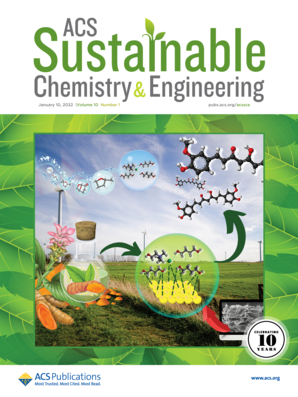倍半氯化乙基铝催化的氢烷基加成:由茂金属催化的高碳α-烯烃二聚体和氯化烷烃制备聚α-烯烃的新途径
IF 7.1
1区 化学
Q1 CHEMISTRY, MULTIDISCIPLINARY
引用次数: 0
摘要
目前,商业上的低粘度聚α烯烃(PAOs)主要是通过传统的bf3催化体系生产的。然而,由于催化剂的有毒、腐蚀性和对环境有害的气体性质,研究人员正在积极研究低粘度PAO生产的替代合成方法。在这项研究中,我们提出了一种新的方法,采用乙基铝介导的烷基化反应将高碳α-烯烃二聚体(不适合作为直接润滑油基础油)和氯化烷烃转化为超低粘度和中高粘度PAO产品。氯化烃在此过程中表现出双重反应性。通过加入三乙基硅烷作为有效的氢供体,并精确控制烯烃二聚体/氯烷烃的比例,我们成功地合成了PAO2和PAO3.5,其超低倾点(- 78℃),选择性为97%,低温性能与商业标准相当。过量的氯化烃经过β-氢转移,生成叔碳阳离子和α-烯烃,然后聚合得到高粘度指数的PAO20。气相色谱(GC)和核磁共振(NMR)分析表明,氯代烃的位阻对反应活性和产物结构有重要影响。只检测到末端烯烃加合物。分子拓扑分析表明,紧凑的分子尺寸有助于降低基础油的倾点。本研究利用加氢烷基化将氯化烷烃转化为高价值的PAO基础油,得到具有明确结构的超低粘度聚α烯烃。通过基片调制实现精确的分子控制,建立了一种结构与性能相关联的润滑油分子工程新技术途径。本文章由计算机程序翻译,如有差异,请以英文原文为准。

Ethylaluminum Sesquichloride-Mediated Hydro-Alkyl Addition: A New Pathway for Producing Polyalphaolefins from Metallocene-Catalyzed High-Carbon α-Olefin Dimer and Chlorinated Alkanes
Currently, commercial low viscosity polyalphaolefins (PAOs) are primarily produced by using traditional BF3-catalyzed systems. However, due to the catalyst’s toxic, corrosive, and environmentally hazardous gaseous properties, researchers are actively investigating alternative synthetic methods for low-viscosity PAO production. In this study, we present a novel approach that employs ethylaluminum sesquichloride-mediated hydro-alkylation to convert high-carbon α-olefin dimers (which are not suitable as direct lubricant base stocks) and chlorinated alkanes into ultralow viscosity and medium-high viscosity PAO products. Chlorinated hydrocarbons demonstrate dual reactivity in this process. By incorporating triethylsilane as an effective hydrogen donor and precisely controlling the olefin dimer/chloroalkane ratio, we successfully synthesized PAO2 and PAO3.5 with ultralow pour points (−78 °C) and a selectivity of 97%, achieving low-temperature performance that is comparable to commercial standards. Excess chlorinated hydrocarbons undergo β-hydrogen transfer, producing tertiary carbocations and α-olefins, which then undergo polymerization to yield PAO20 with an enhanced high viscosity index. Gas chromatography (GC) and nuclear magnetic resonance (NMR) analyses revealed that the steric hindrance of chlorinated hydrocarbons plays a significant role in influencing reaction activity and the architecture of the resulting products. Only terminal olefin adducts were detected. Molecular topology analysis indicated that compact molecular dimensions promote pour point depression in base oils. This study utilized hydro-alkylation to transform chlorinated alkanes into high-value PAO base oils, yielding ultralow viscosity polyalphaolefins with well-defined architectures. By achieving precise molecular control through substrate modulation, we established a novel technical approach for lubricant molecular engineering with a correlation between structure and performance.
求助全文
通过发布文献求助,成功后即可免费获取论文全文。
去求助
来源期刊

ACS Sustainable Chemistry & Engineering
CHEMISTRY, MULTIDISCIPLINARY-ENGINEERING, CHEMICAL
CiteScore
13.80
自引率
4.80%
发文量
1470
审稿时长
1.7 months
期刊介绍:
ACS Sustainable Chemistry & Engineering is a prestigious weekly peer-reviewed scientific journal published by the American Chemical Society. Dedicated to advancing the principles of green chemistry and green engineering, it covers a wide array of research topics including green chemistry, green engineering, biomass, alternative energy, and life cycle assessment.
The journal welcomes submissions in various formats, including Letters, Articles, Features, and Perspectives (Reviews), that address the challenges of sustainability in the chemical enterprise and contribute to the advancement of sustainable practices. Join us in shaping the future of sustainable chemistry and engineering.
 求助内容:
求助内容: 应助结果提醒方式:
应助结果提醒方式:


